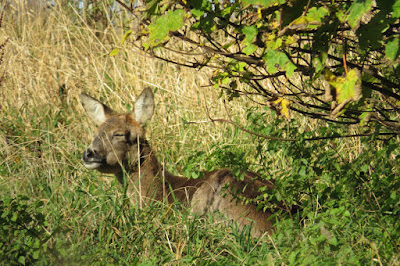A largely sunny morning after a chilly night. I saw a small patch of frost beneath a hedge, but the day was soon quite mild with a light south-westerly.
After seeing a small party of Redwings over my house this morning, I was hoping this would be replicated at Morton Bagot, but actually there were just a few in the hedgerows, and no overhead passage at all.
That said, I did manage to break my patch record count for Stonechats. A total of nine comprised six in the chat field and three in the ridge field.
 |
| Stonechat |
I wandered down to the south end where there are still reasonable numbers of Meadow Pipits, and I saw the first of an eventual count of three Yellowhammers. This is the largest count of a very poor year for the species here. At one point the corvids and pigeons seemed restless and spooked, which led me to check the pylons. Sure enough a Peregrine was hunched up there.
The sunshine encouraged quite a few insects to fly around, several Red Admirals and one or two other dark butterflies, a couple of Migrant Hawkers, and one or two unidentified Darters.
 |
| Migrant Hawker |
The pool still has a fair bit of water in it, while the nearest flash is full of water and ducks, and the furthest flash has a bit of an edge and was full of Greylag Geese and a few barely visible Lapwings.
The highlight was first Little Egret for a month or two, which flew towards the furthest flash.
 |
| Little Egret through a hedge. |
The Wigeon seems to have gone but I counted 37 Teal, 61 Mallard, four Shovelers, and 201 Greylag Geese. So still no shooting, which is good. I counted 55 Pheasants, which suggests that some have been released nearby. At one point I heard a quad-bike backfiring its way around the strip field, so I wondered whether someone was trying to encourage them to leave the safety of Morton Bagot.
I'm currently two species short of breaking my record year list for birds on the patch, but the wait for a new bird is now stretching my patience. Its a good job its a lovely place anyway.


























